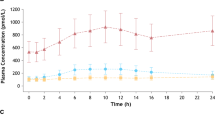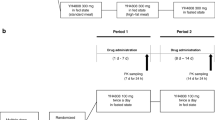Summary
In 10 healthy male subjects the pharmacokinetics and haemodynamic effects of sustained-release isosorbide-5-mononitrate 60 mg (IS-5-MN) were studied after oral administration at two different times in the day (08.00 h and 20.00 h). Effects on blood pressure and heart rate after 3 min standing upright were measured in relation to the individual circadian control values.
The pharmacokinetic parameters (Cmax, tmax, AUC, t1/2) did not differ after morning and after evening dosing, tmax being 5.2 h and 4.9 h, respectively. In contrast, the cardiovascular effects of IS-5-MN were clearly circadian phase-dependent. The maximum decrease in blood pressure decrease and increase in heart rate occurred significantly earlier after the evening (BPsys 2.8 h; BPdia 2.9 h; HR 3.8 h) than after the morning dose (BPsys 5.0 h; BPdia 6.0 h; HR 5.2 h). Thus, the peak haemodynamic effects coincided with the peak drug concentration after the morning dose, whereas the peak effect was in advance of the peak drug concentration after the evening dose of IS-5-MN.
The data provide evidence of circadian phase-dependency in the dose-response relationship of oral IS-5-MN.
Similar content being viewed by others
References
Raftery EB (1983) The effects of beta-blocker therapy on diurnal variation of blood pressure. Eur Heart J 4: 61–64
Semenowizc-Siuda K, Markiewicz A, Korczynska-Wardecka J (1984) Circadian bioavailability some effects of propranolol in healthy subjects and liver cirrhosis. Int. J Clin Pharmacol Ther Toxicol 22: 653–658
Langner B, Lemmer B (1988) Circadian changes in the pharmacokinetics and cardiovascular effects of oral propranolol in healthy subjects. Eur J Clin Pharmacol 33: 619–624
Lemmer B (1989) Circadian variations in the effects of cardiovascular active drugs. In: v Arnim Th, Maseri A (eds) Predisposing conditions for acute ischemic syndromes. Steinkopff, Darmstadt, pp 1–12
Lemmer B (1989) Temporal aspects of the effects of cardiovascular active drugs. In: Lemmer B (ed) Chronopharmacology — cellular and biochemical interactions. Dekker, New York, pp 525–541
Araki H, Koiwaya Y, Nakagaki O, Nakamura M (1983) Diurnal distribution of ST-segment elevation and related arrhythmias in patients with variant angina: a study by ambulatory ECG monitoring. Circulation 67: 995–1000
Waters DD, Miller DD, Bouchard A, Bosch X, Theroux P (1984) Circadian variation in variant angina. Am J Cardiol 54: 61–64
Hausmann D, Nikutta P, Hartwig C-A, Daniel WG, Wenzlaff P, Lichtlen PR (1987) ST-Strecken-Analyse im 24-h-Langzeit-EKG bei Patienten mit stabiler Angina pectoris und angiographisch nachgewiesener Koronarsklerose. Z Kardiol 76: 554–562
Master AM (1960) The role of effort and occupation in coronary occlusion. JAMA 174: 942–948
Muller JE, Stone PH, Turin ZG, Rutherford JG, Czeisler CA, Parkers C, Poole WK, Passamani E, Roberts R, Robertson T, Sobel BE, Willerson JT, Braunwald E (1985) The Milis study group: Circadian variation in the frequency of onset of acute myocardial infarction. N Engl J Med 313: 1315–1322
Arnim von T, Höfling B, Schreiber M (1985) Characteristics of episodes of ST elevation or ST depression during ambulatory monitoring in patients subsequently undergoing coronary angiography. Br Heart J 54: 484–488
Yasue H, Omote S, Takizawa A, Nagao M, Miwa K, Tanaka S (1979) Circadian variation of exercise capacity in patients with Prinzmetal's variant angina: role of exercise-induced coronary arterial spasm. Circulation 59: 938–948
Blume H, Scheidel B, Becker HJ, Renczes J, Lemmer B (1986) Chronopharmacology of oral isosorbide dinitrate in healthy subjects. Naunyn-Schmiedeberg's Arch Pharmacol 332: R 57
Reference deleated
Lemmer B, Scheidel B, Stenzhorn G, Blume H, Lenhard G, Grether D, Renczes J, Becker HJ (1989) Clinical chronopharmacology of oral nitrates. Z Kardiol 78 [Suppl 2]: 61–63
Scheidel B, Wenzel B, Blume H (1989) Analytik von Arzneistoffen aus biologischem Material im Rahmen von Pharmakokinetik/Bioverfügbarkeits-Studien. 1. Mitteilung: Simultane Bestimmung von Isosorbiddinitrat und seinen Metaboliten Isosorbid-2-Mononitrat und Isosorbid-5-Mononitrat. Pharm Ztg Wiss 3: 163–168
Witte K, Hohmann W, Lemmer B (1989) Pharmfit - modified fitting program for IBM computers, based on McIntosh JEA, McIntosh RP (1980) Mathematical Modelling and Computers in Endocrinology. Springer, Berlin
Nakano S, Watanabe H, Nagai K, Ogawa N (1984) Circadian stage-dependent changes in diazepam kinetics. Clin Pharmacol Ther 36: 271–277
Lemmer B, Behne S, Becker HJ (1989) Chronopharmacology of oral nifedipine in healthy subjects. Eur J Clin Pharmacol 36 [Suppl]: A 177
Smolensky MH (1989) Chronopharmacology of theophylline and beta-sympathomimetics. In: Lemmer B (ed) Chronopharmacology — cellular and biochemical interactions. Dekker, New York, pp 65–113
Guissou P, Cuisinaud G, Llorca G, Lejeune E, Sassard J (1983) Chronopharmacokinetic study of a prolonged release form of indomethacin. Eur J Clin Pharmacol 24: 667–670
Mullen PE, Lightman S, Linsell C, McKeon P, Sever PS, Todd K (1981) Rhythms of plasma noradrenaline in man. Psychoendocrinology 6: 213–222
Lemmer B (1988) Die Bedeutung der Chronopharmakologie für die medikamentöse Therapie. Verh Dtsch Ges Inn Med 94: 420–430
Lemmer B, Winkler H, Ohm T, Fink M (1985) Chronopharmacokinetics of beta-receptor blocking drugs of different lipophilicity (propranolol, metoprolol, sotalol, atenolol) in plasma and tissues after single and multiple dosing in the rat. Naunyn-Schmiedeberg's Arch Pharmacol 330: 42–49
Lemmer B, Bärmeier H, Schmidt S, Lang P-H (1987) On the daily variation in the beta-receptor — adenylate cyclase — cAMP — phosphodiesterase system in rat forebrain. Chronobiol Int 4: 469–475
Lemmer B, Lang P-H, Schmidt S, Bärmeier H (1987) Evidence for circadian rhythmicity of the beta-adrenoceptor — adenylate cyclase — cAMP — phosphodiesterase system in the rat. J Cardiovasc Pharmacol 10: S138-S140
Hossmann V, FitzGerald GA, Dollery CT (1980) Circadian rhythm of baroreflex reactivity and adrenergic vascular response. Cardiovasc Res 14: 125–129
Aschoff J, Aschoff J (1969) Tagesperiodik der orthostatischen Kreislaufreaktion. Pflügers Arch 306: 146–152
Reference deleated
Scheidel B, Lenhard G, Blume H, Becker HJ, Lemmer B (1989) Chronopharmacology of isosorbide-5-mononitrate (immediate release, retard formulation) in healthy subjects. Eur J Clin Pharmacol 36 [Suppl]: A 177
Author information
Authors and Affiliations
Rights and permissions
About this article
Cite this article
Lemmer, B., Scheidel, B., Blume, H. et al. Clinical chronopharmacology of oral sustained-release isosorbide-5-mononitrate in healthy subjects. Eur J Clin Pharmacol 40, 71–75 (1991). https://doi.org/10.1007/BF00315142
Received:
Accepted:
Issue Date:
DOI: https://doi.org/10.1007/BF00315142




